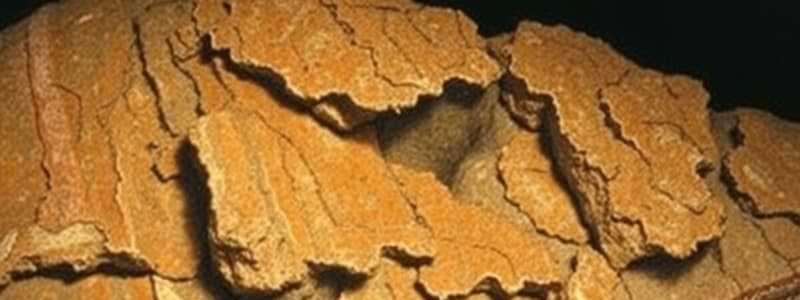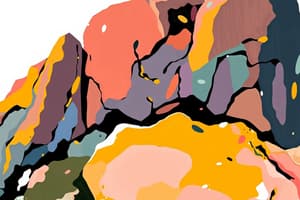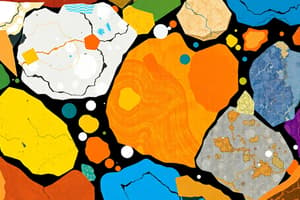Podcast
Questions and Answers
Which of the following processes is NOT a primary way minerals typically form?
Which of the following processes is NOT a primary way minerals typically form?
- Precipitation from solutions, like in alkaline lakes
- Direct synthesis in a laboratory setting (correct)
- Crystallization from cooling magma or lava
- Deposition from underground water filling cracks
What is the role of the Earth's oceans in mineral formation?
What is the role of the Earth's oceans in mineral formation?
- The oceans primarily dilute elements, preventing mineral formation.
- The oceans solely contribute to the erosion of existing minerals.
- The oceans contain dissolved elements that can precipitate to form minerals. (correct)
- The oceans only support mineral formation in extreme volcanic regions.
How do tufa towers, such as those found in Mono Lake, form?
How do tufa towers, such as those found in Mono Lake, form?
- As a result of seismic activity fracturing the lake bed.
- By the erosive action of waves on volcanic rock formations.
- Through the deposition of calcite from alkaline-rich water bubbling up into the lake. (correct)
- Through the rapid cooling of lava flows under alkaline water.
What geological setting primarily leads to the formation of mineral veins?
What geological setting primarily leads to the formation of mineral veins?
Which factor is LEAST important in determining the type of rock that forms?
Which factor is LEAST important in determining the type of rock that forms?
How do igneous rocks form?
How do igneous rocks form?
What is the defining characteristic of sedimentary rocks?
What is the defining characteristic of sedimentary rocks?
What process creates metamorphic rocks?
What process creates metamorphic rocks?
What is the rock cycle?
What is the rock cycle?
How are all three rock types related in the rock cycle?
How are all three rock types related in the rock cycle?
What geological processes are responsible for the weathering and erosion of rocks?
What geological processes are responsible for the weathering and erosion of rocks?
What happens to a rock during metamorphism?
What happens to a rock during metamorphism?
Which of the following is the MOST significant factor driving the rock cycle?
Which of the following is the MOST significant factor driving the rock cycle?
What is the PRIMARY difference between magma and lava?
What is the PRIMARY difference between magma and lava?
Which of the following is LEAST likely to be a direct agent of erosion?
Which of the following is LEAST likely to be a direct agent of erosion?
Why might a geologist study rocks?
Why might a geologist study rocks?
Which process typically occurs at convergent plate boundaries and contributes significantly to the rock cycle?
Which process typically occurs at convergent plate boundaries and contributes significantly to the rock cycle?
How does the rate of cooling affect the crystal size in an igneous rock?
How does the rate of cooling affect the crystal size in an igneous rock?
What is the most likely environment for the formation of a sedimentary rock composed primarily of rounded gravel?
What is the most likely environment for the formation of a sedimentary rock composed primarily of rounded gravel?
Which of the following describes why rocks are non-living?
Which of the following describes why rocks are non-living?
Flashcards
Mineral Formation from Magma
Mineral Formation from Magma
Minerals can form from cooling lava and magma after rocks melt due to high temperatures.
Mineral Formation from Solutions
Mineral Formation from Solutions
Minerals can precipitate out of solutions, such as elements in Earth's oceans or saltwater.
Calcite Tufa Tower Formation
Calcite Tufa Tower Formation
Alkaline-rich water deposits calcite, forming structures like tufa towers when lake levels drop.
Mineral Vein Formation
Mineral Vein Formation
Signup and view all the flashcards
Rock Cycle
Rock Cycle
Signup and view all the flashcards
Rock Definition
Rock Definition
Signup and view all the flashcards
Igneous Rocks
Igneous Rocks
Signup and view all the flashcards
Sedimentary Rocks
Sedimentary Rocks
Signup and view all the flashcards
Metamorphic Rocks
Metamorphic Rocks
Signup and view all the flashcards
Cooling and Crystallization
Cooling and Crystallization
Signup and view all the flashcards
Wind and Erosion
Wind and Erosion
Signup and view all the flashcards
Metamorphism
Metamorphism
Signup and view all the flashcards
Study Notes
Mineral Formation
-
Minerals can form because of lava and magma, this can happen because in some places the rocks are so hot they melt
-
After they cool, those are minerals that have formed
-
Minerals can solve because of Solutions, the earths oceans are full of elements and these elements can create minerals
-
Salt water also creates precipates, this happens when calcite is deposited in alkaline rich water such as that in Mono Lake in canada
-
The water bubbles up into the alkaline lake. The calcite tufa towers form, when lake levels drop, the tufa towers are revealed
-
Underground water can be heated my the earth, and if there are cracks in the ground, that water will fill in the cracks, this water is usually full of particles and when it fills the cracks the water deposits the minerals and creates veins
Rocks
-
THe rock cycle is when one type of rock changes into another
-
A rock is a naturally formed and occurring non living earth material
-
Rocks are made of many minerals and some of these minerals are so small you cannot see it
-
Rocks are named for the combinations of minerals they are made of and the way those minerals came together
-
Geologists are people who study rocks
-
Igneous rocks form when magma cools on the Earths Surface
-
They can also form deep in the crust
-
Sedimentary rocks are made when sediments are packed together very tightly. Sediments are pieces of rock like gravel, sand, silt or clay
-
Metamorphic rocks are made when an existing rock is changed by heat and pressure. The minerals in the rock change but they do not melt
Rock Cycle Process
-
Rocks can be formed from volcano eruptions or compacted by sand
-
Any rock can change from its form to another one
-
These changes usually take a long time
-
All the three rock types are all related to one another in some way
-
Cooling and crystallization are one of the ways that these rocks can change
-
Wind and erosion, wind, ice and even plants and animals can all cause rocks to change and erode
-
Metamorphism is when a rock is exposed to high temperatures and high temperatures, with metamorphism, the rock does not completely melt away
-
These kind of changes can create new mineral composition or new texture
Igneous ROcks
-
Igneous rocks are everywhere, and parts of the earth's crust is made out of igneous rocks
-
An igneous rocks looks can change depending on two things the size or amount of the magma that cooled and the other is fast how the magma cooled
Sediments are everywhere, an example of a sediment would be something like sand -
They have to be packed together very tightly in order to achieve this sediment rock status
-
Sediments can also be fragments of rock and minerals that would vary in size
-
They can also contain fossils as most fossils are trapped in layers of sediment
-
They can be transported by wind, water, ice or gravity
-
They are then deposited in a location
-
Sediments will eventually settle out of water
-
If a river slows, it will deposit sediment along its banks
-
When they settle outside of water, they form horizontal layers stacking the sediments and compressing them on top of each other
-
Clastic Sediments are ones formed by being compacted, but chemical sedimentaries also form when mineral crystals precipitate from saline or salt water
Lithification of Sedimentary Rocks
-
Sandstone is a rock that has weathered and eroded
-
Clastic rocks are made of sediments, which are called clasts
-
Creating rocks from sediments is called lithification
-
Chemicals precipitate from liquid to form chemical sedimentary rocks
-
Over time, deposited sediments may harden into rocks
-
First, the sediments are compacted, squeezed together by pressure and weight
-
Next the sediments are cemented together, minerals fill in the space between the loose sediment particles
-
These cementing minerals came from the water that moves through the sediment
-
Chemical sedimentary rocks form when the crystals precipitate out from the liquid
-
The mineral halite, also known as rock salt is made in this way by leaving salt water in the sun
-
Cementification is when liquid fills a gap with mineral water
Metamorphic rocks always start off as another type of rock
-
During metamorphism for rocks, ions move in or out of a mineral, thereby creating a different material
-
The new minerals are more stable in the new environment
-
Extreme pressure can lead to physical change, meaning if pressure is applied to one side of the rock, it creates layers of rock
-
This is called foliation
-
If pressure is exerted from all sides the rock usually shows no foliation
-
Contact Metamorphism occurs when magma contacts a rock
-
Even if the rock does not get hot enough to melt, the magmas extreme heat will change the rock
-
Regional Metamorphism occurs over a wide area
-
Great masses of rock are exposed to pressure from rock and sediment layers on top of it
-
The rock can also be compressed by other geologic processes such as tectonic plate movements
-
Metamorphism does not completely melt the rock, it only causes minerals to change
-
If the rock does melt, it will cool to become an igneous rock
-
Hornfels is a rock with alternating colors of dark and light crystals
-
It is a good example of how minerals rearrange themselves during metamorphosis
Studying That Suits You
Use AI to generate personalized quizzes and flashcards to suit your learning preferences.




